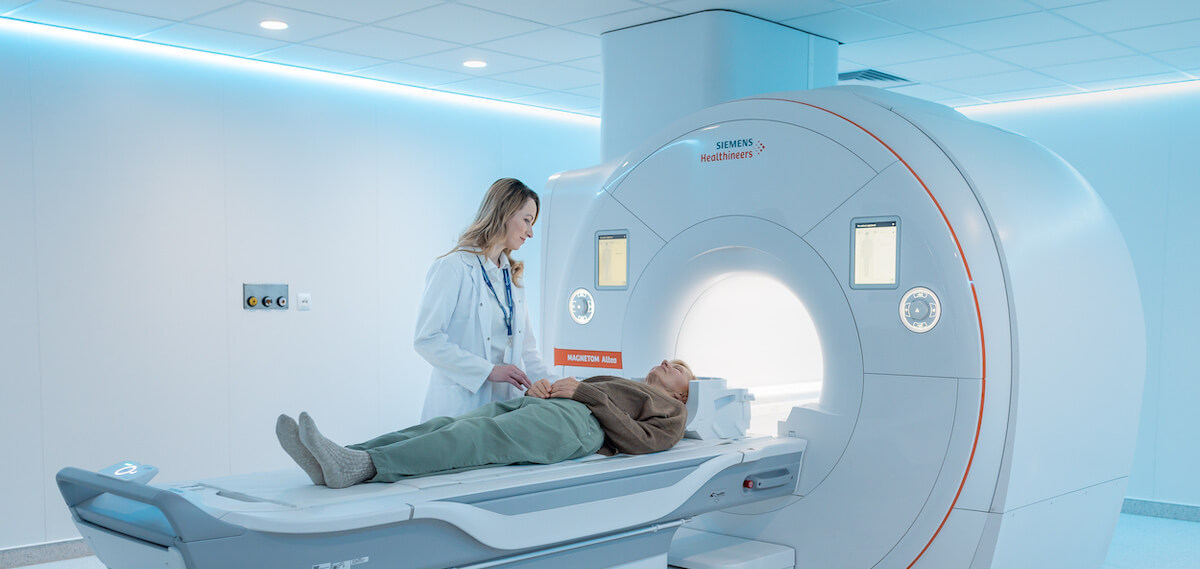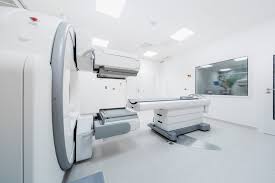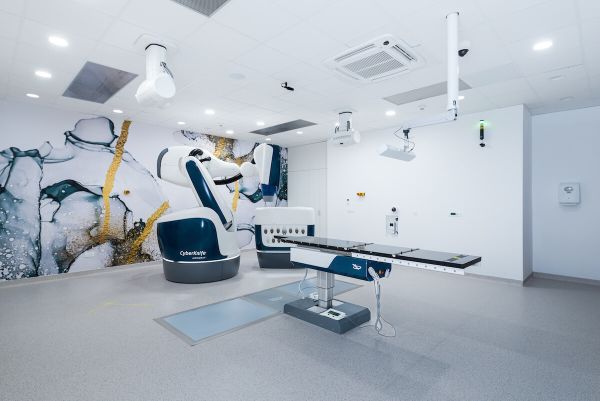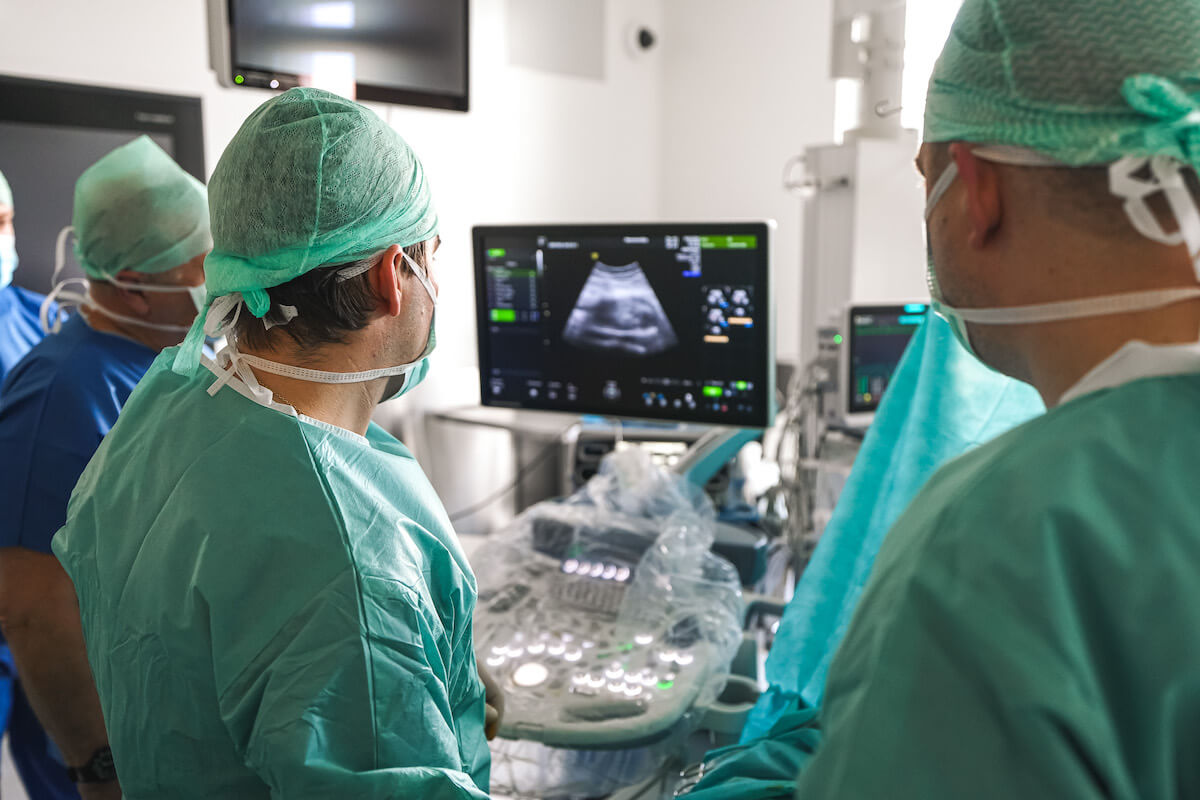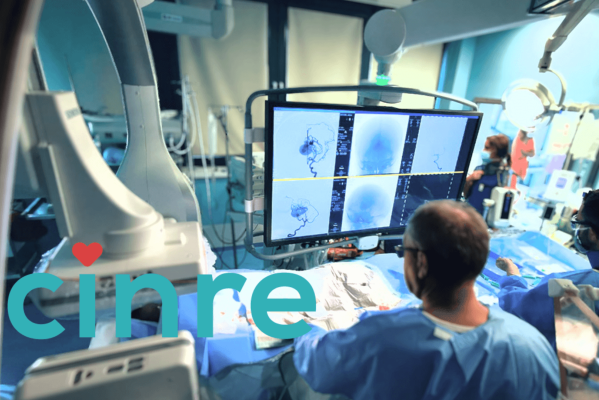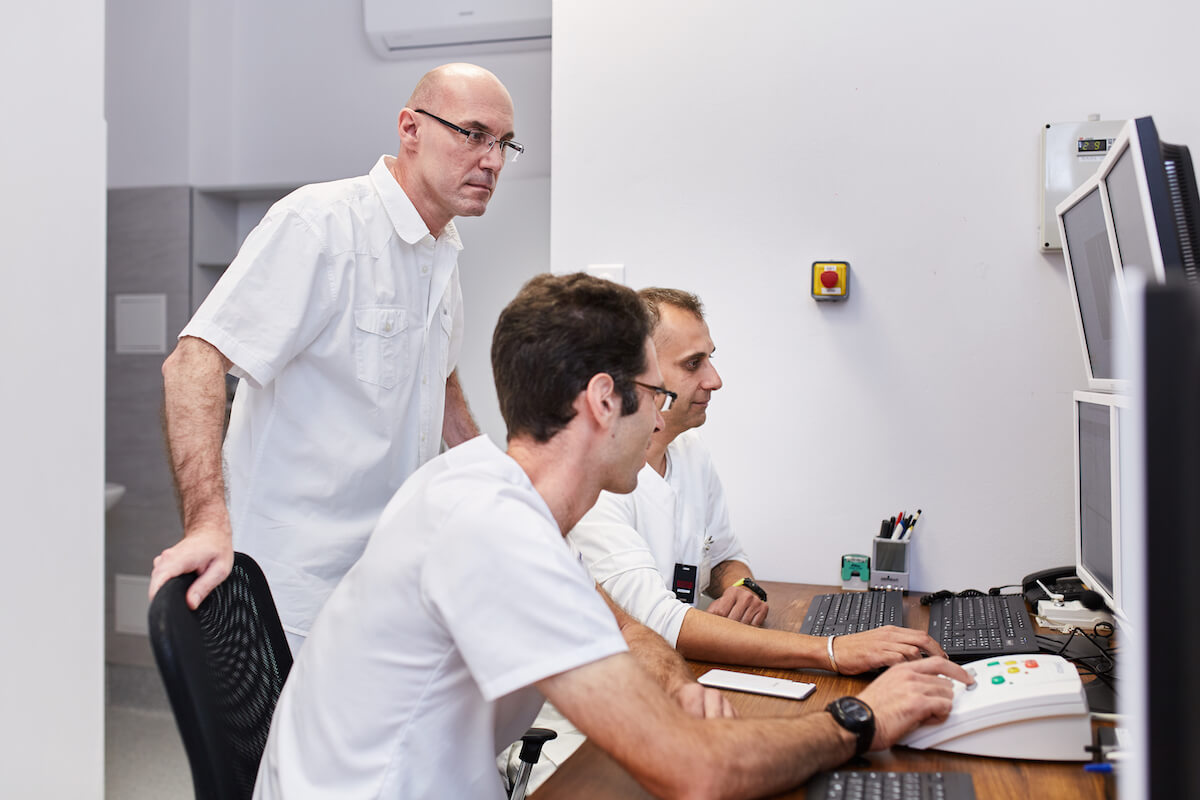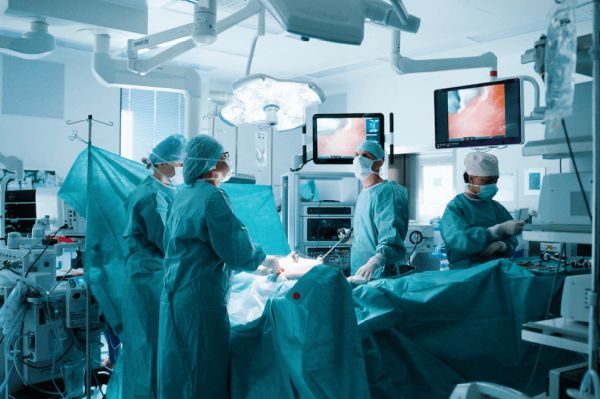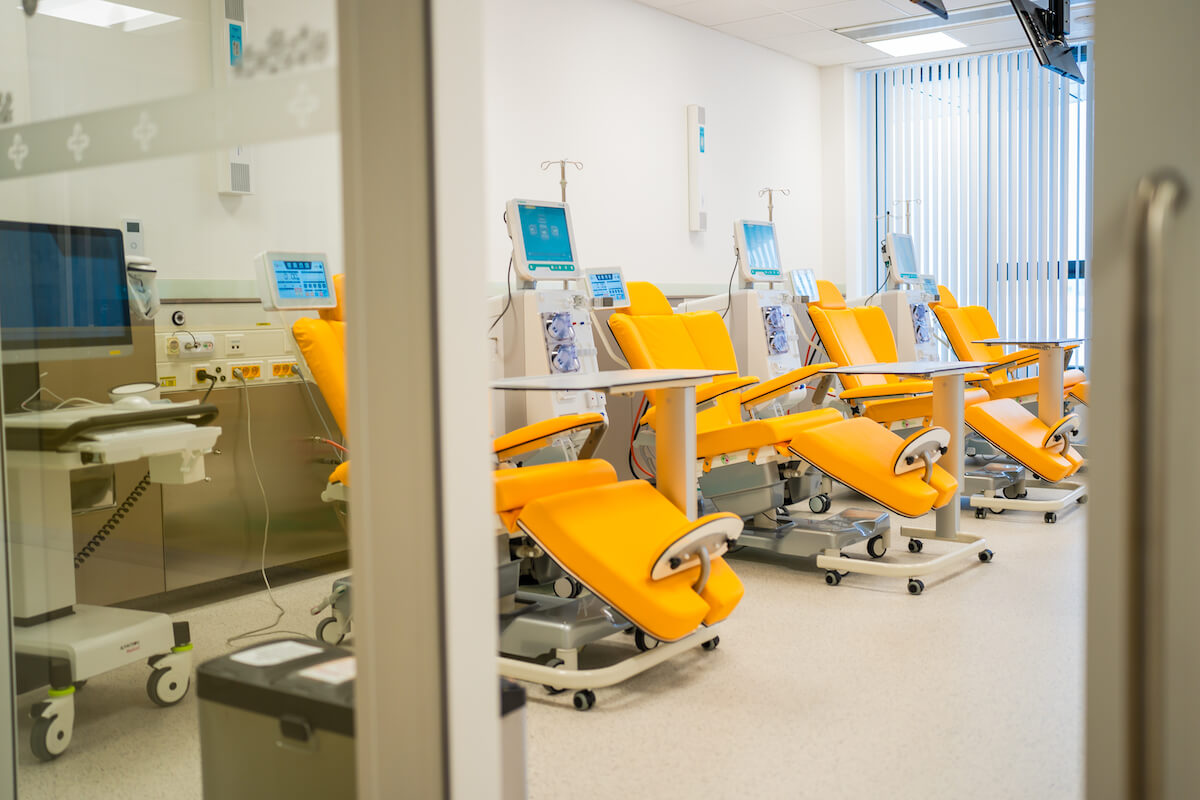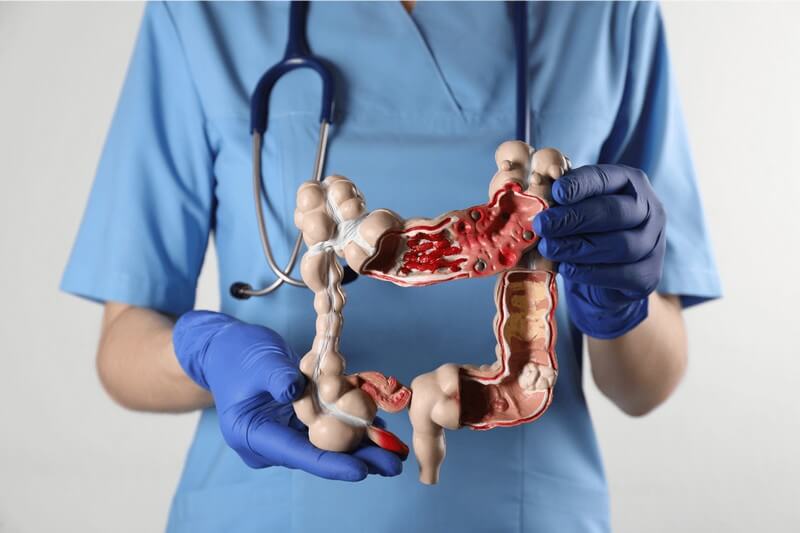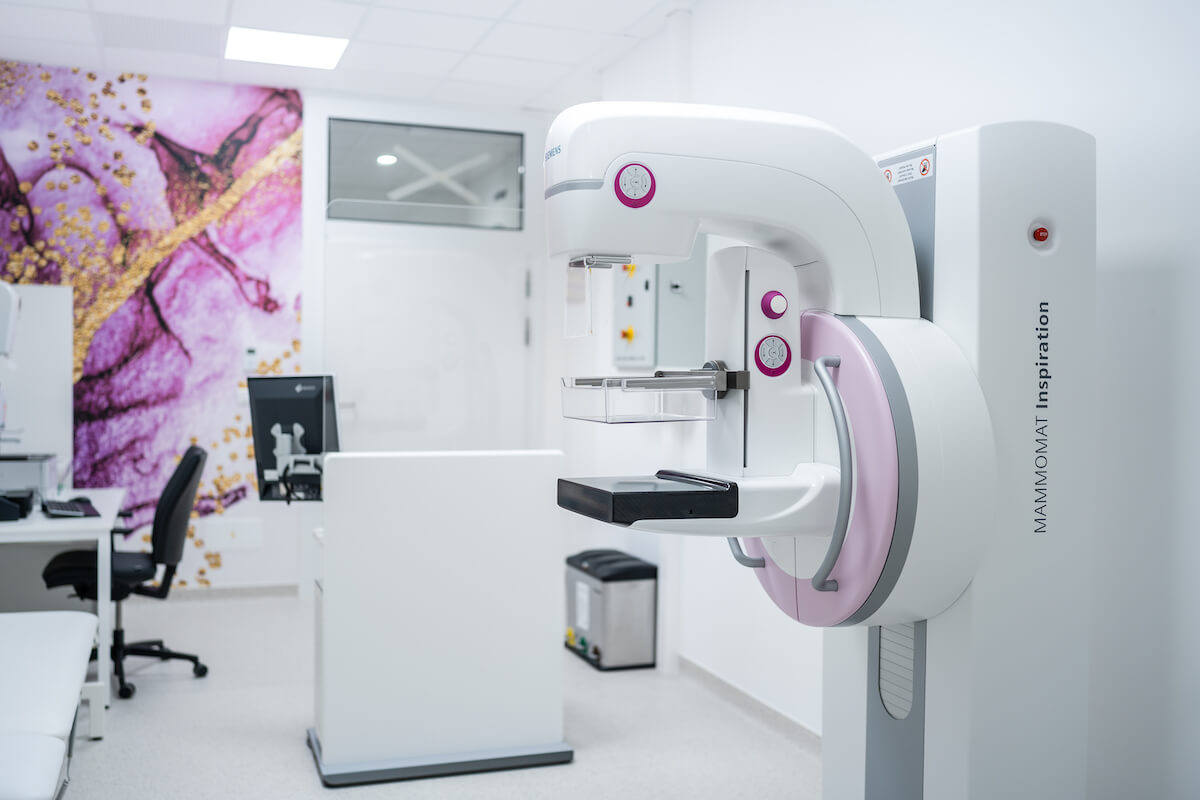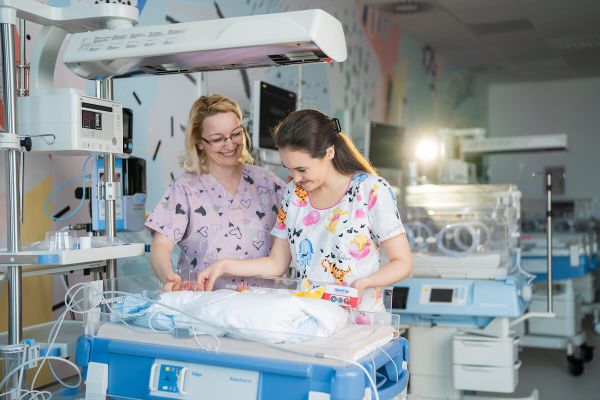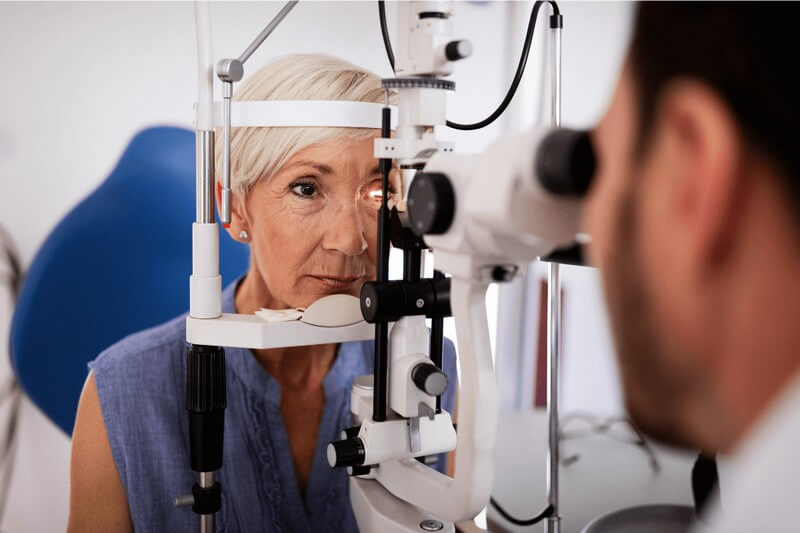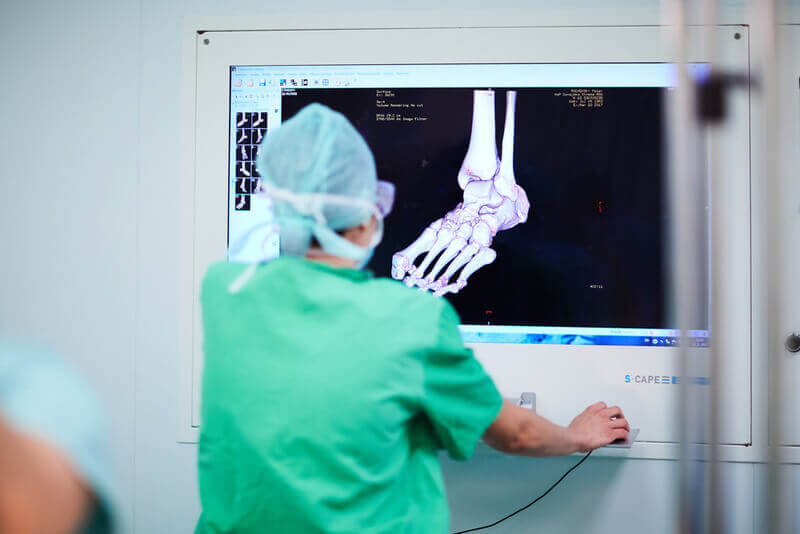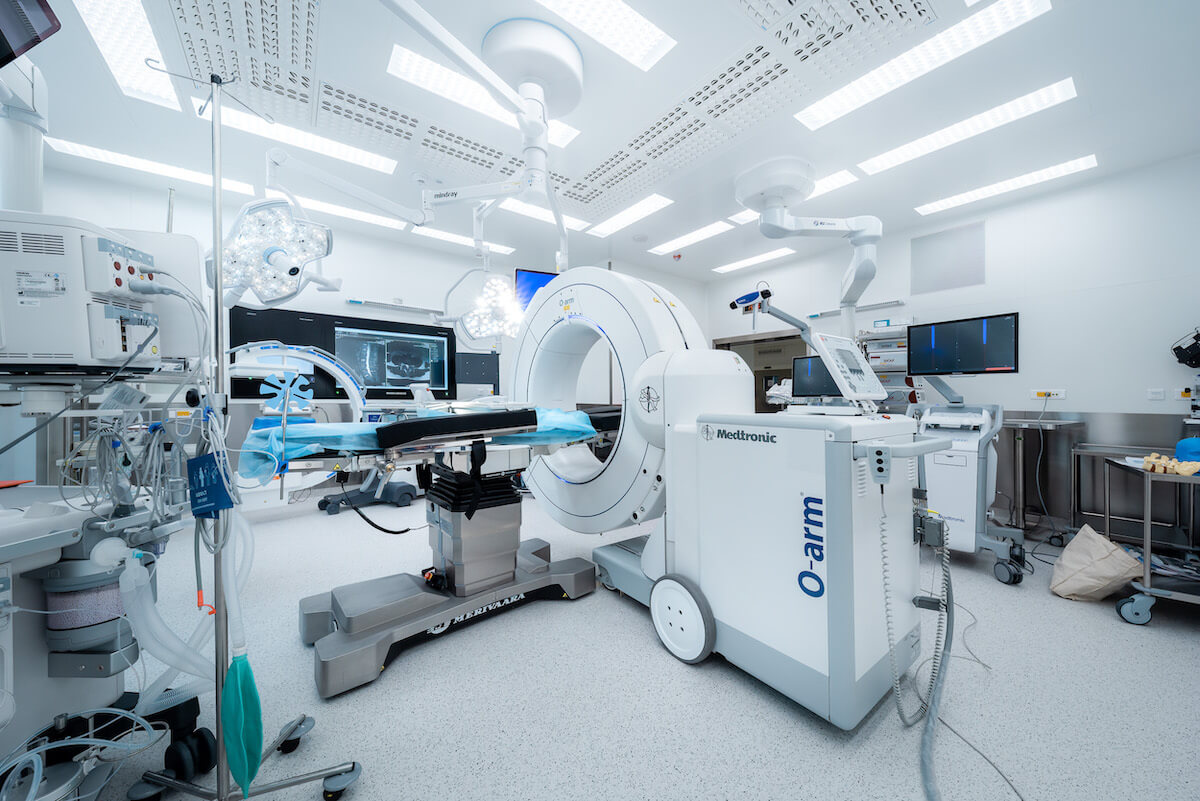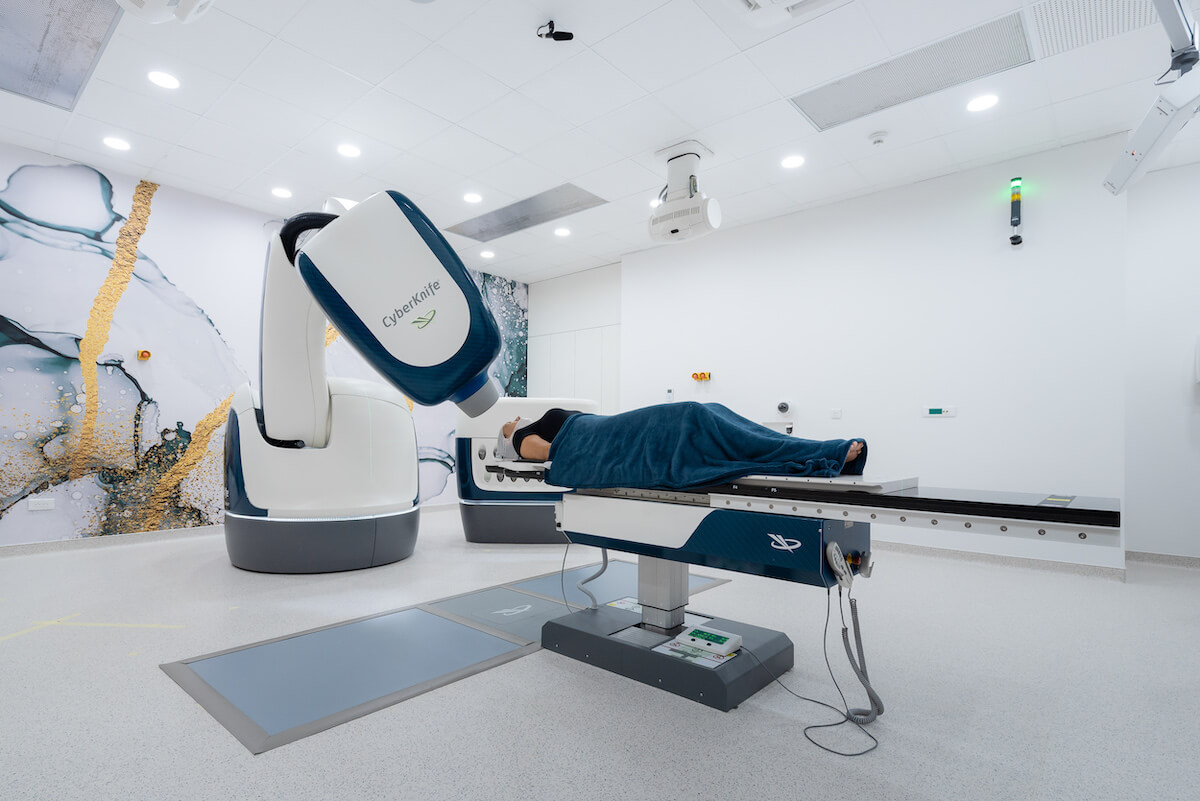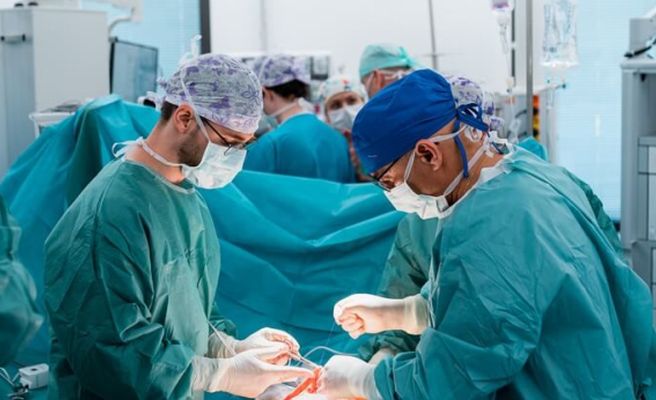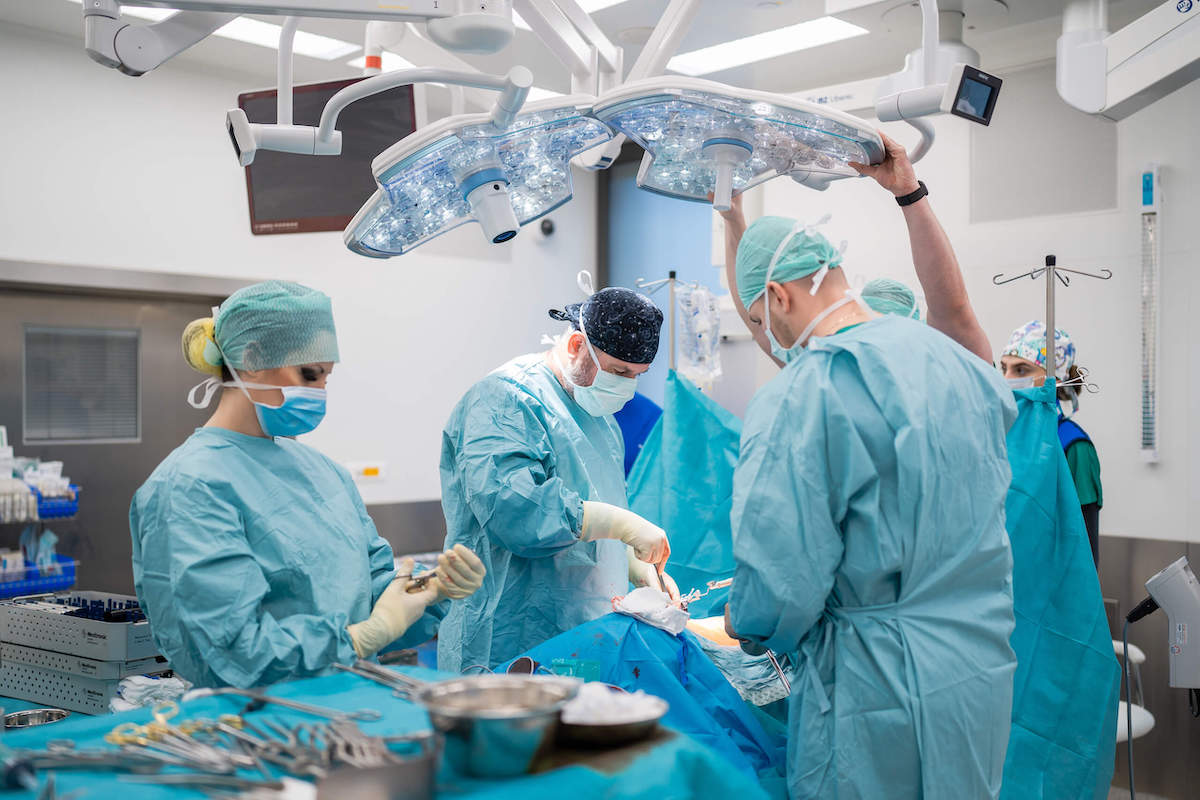How to Schedule an Examination
First and foremost, it’s important to know that a patient schedules an appointment for an examination at the clinic based on a referral from a doctor. The referral must be brought to the examination.
You can schedule an appointment for an examination or other procedure:
- By phone through the contact center at 0950 105 510 from 7:00 AM to 5:00 PM.
- In person at the Bory Hospital receptions only from 7:00 AM to 3:30 PM.
- Appointment directly through the specialist doctor.
One family member or close companion may stay with the patient in the room. This service is chargeable according to the current PRICE LIST with fees available on our website.


Transportation to Bory Hospital
Do you have a scheduled surgery or procedure at Bory Hospital and need transportation? Patients who are insured by Dôvera Health Insurance can now take advantage of their benefit—free transportation to Bory Hospital.
This service provides transportation once a year for hospitalization from anywhere in Slovakia and back home through the Health Transport Service of Svet zdravia. The benefit does not apply to initial outpatient examinations. More information about this benefit can be found on Dôvera’s website.
Diagnostic Units at Bory Hospital
Procedures Performed at Bory Hospital
Surgical Procedures
Surgical Procedures Offered at Bory Hospital:
- Gallbladder surgery (both laparoscopic and open)
- Hernia surgery (inguinal, umbilical, or abdominal wall) — laparoscopic and open
- Appendectomy (laparoscopic)
- Laparoscopic revision of the abdominal cavity (adhesiolysis)
- Hemorrhoid surgery (open, laser, painless Longo method, gentle HAL-RAR method)
- Surgery for fissures
- Surgery for fistulas
- Varicose vein surgery (of the lower extremities)
Surgical Procedures for Oncology Patients
- Abdominal surgeries for the liver, pancreas, small intestine, and large intestine (robotic, laparoscopic, and open surgery)
- Breast-conserving surgeries
- Mastectomies
- Axillary lymph node dissection
- Sentinel lymph node dissection
- Excision of benign breast tumors
- Excision of skin and subcutaneous tumors
Urological Surgical Procedures and Examinations
- Ablation of genital warts (condylomas)
- Shockwave therapy for Peyronie's disease (induratio penis plastica)
- Retrograde (ascending) ureteropyelography for precise diagnosis of suspicious findings in the upper urinary tract
- Male sterilization (bilateral vasectomy)
- Kidney biopsy
- Circumcision
- Cystoscopy – endoscopic examination of the urethra and bladder
- Diagnostic ureteroscopy (URS)
- Urethral dilation
- Cystolithotripsy – crushing and suctioning of stones in the bladder
- Excision of small skin lesions
- Extracorporeal lithotripsy (LERV) – juxtavesical ureterolithiasis
- Extracorporeal lithotripsy (LERV) – nephrolithiasis
- Extracorporeal lithotripsy (LERV) – subrenal ureterolithiasis
- Frenuloplasty
- Plastic correction of cystoenterorectal prolapse
- Laparoscopic adrenalectomy
- Laparoscopic nephrectomy
- Laparoscopic nephroureterectomy
- Laparoscopic varicocele surgery
- Laparoscopic pyeloplasty
- Laparoscopic radical prostatectomy
- Laparoscopic kidney resection
- Testicular tissue biopsy for reproduction (MESA, TESE)
- Nephrostomogram
- Hydrocele surgery
- Hypospadias repair
- Retroperitoneal tumor surgery
- Penile tumor surgery
- Spermatocele surgery
- Micro-surgical varicocele repair
- Optical urethrotomy
- Orchiectomy, epididymectomy
- Open inguinal lymphadenectomy
- Open nephrectomy/radical nephrectomy
- Open nephroureterectomy
- Open pyeloplasty
- Open radical cystectomy with continent urinary diversion – male
- Open radical cystectomy with continent urinary diversion – female
- Open radical cystectomy with ureteroileostomy – male
- Open radical cystectomy with ureteroileostomy – female
- Open radical prostatectomy
- Open ureter reimplantation
- Open kidney resection
- Open retroperitoneal lymphadenectomy
- Percutaneous stone extraction (PEK)
- Plastic surgeries on the penis
- Renal cyst puncture
- Puncture cystostomy
- Puncture nephrostomy
- Radical orchiectomy, resection of testicular tumor, testicular revision for tumor
- Surgical repositioning of paraphimosis, dorsal incision
- Revision of the scrotal contents for non-tumor conditions
- Robot-assisted pyeloplasty
- Robot-assisted radical prostatectomy
- Robot-assisted ureter reimplantation
- Robot-assisted kidney resection
- Robot-assisted radical cystectomy
- Transrectal prostate biopsy
- Transperineal prostate biopsy
- Transperineal/transrectal placement of seeds before radiotherapy
- Transperineal placement of protective gel before radiotherapy
- Transurethral incision of the prostate
- Transurethral resection of the prostate
- Transurethral resection of bladder tumor (TUR)
- Transvesical (open) prostatectomy (TVPE)
- Ureterorenoscopy – endopyelotomy, endoureterotomy (EPT, EUT)
- Ureterorenoscopy – removal of urinary stone
- Urethroplasty
- Urodynamic examination
- Replacement of cystostomy
- Replacement of nephrostomy
- Insertion or replacement of ureteral stent
Otorhinolaryngological (ENT) Procedures
- Insertion of Ventilation Tube: Placement of a ventilation tube in the eardrum for poor eustachian tube function.
- Meatoplasty: Surgical reconstruction of the ear canal.
- Myringoplasty: Repair of the eardrum.
- Tympanoplasty: Surgical reconstruction of the middle ear.
- Stapedotomy: Surgery to improve hearing by replacing the stapes bone.
- Ear Surgery for Cholesteatoma: Treatment for cholesteatoma in the middle ear.
- Endoscopic Ear Surgery: Minimally invasive procedures for ear conditions.
- Implantation of Active Middle Ear Implants: For hearing impairment.
- Otoplasty: Ear reshaping surgery.
- Surgery for Dehiscent Semicircular Canal: Repair of the semicircular canal.
- Ear Tumor Surgery: Removal of tumors in the ear.
- Closure of Perilymphatic Fistula: Repair of pathological communication between the inner and middle ear.
- Sanation of Ear During Acute Otitis Media: Surgical intervention during acute middle ear infections.
- Vestibular Schwannoma Surgery: Treatment for vestibular schwannoma and tumors of the internal auditory canal.
- Adenoidectomy: Removal of the adenoids.
- Tonsillotomy: Partial removal of the tonsils.
- Tonsillectomy: Complete removal of the tonsils.
- Frenuloplasty of the Tongue: Surgery to correct tongue tie.
- Uvulopalatopharyngoplasty: Surgery to remove excess tissue in the throat.
- Removal of Medial Neck Cyst: Excision of thyroglossal duct cysts.
- Removal of Lateral Neck Cyst: Excision of lateral neck cysts.
- Skin Tumor Surgery of the Head and Neck: Reconstruction after tumor removal.
- Laryngeal Surgery for Tumors: Surgical intervention for benign and malignant tumors of the larynx.
- Laser Surgery on the Larynx: Minimally invasive procedures using lasers.
- Surgery for Laryngeal and Tracheal Stenosis: Procedures to widen narrowed airways.
- Partial Laryngectomy: Removal of part of the larynx.
- Total Laryngectomy: Complete removal of the larynx.
- Insertion of Phonatory Prosthesis: Rehabilitation for voice restoration post-laryngectomy.
- Voice Improvement Surgery on the Larynx: Surgical techniques to enhance voice quality.
- Thyroid Surgery: Procedures related to the thyroid gland.
- Surgery for Parathyroid Disorders: Surgical intervention for parathyroid diseases.
- Tracheotomy: Surgical creation of an opening in the trachea.
- Parotid Gland Surgery: Operations on the parotid gland.
- Pharyngeal Tumor Surgery: Surgical removal of para-pharyngeal tumors.
- Submandibular Salivary Gland Surgery: Operations on the submandibular gland.
- Head and Neck Tumor Surgery: Procedures for benign and malignant tumors.
- Oral Cavity and Pharyngeal Tumor Surgery: Surgical interventions for tumors in these areas.
- Cervical Lymph Node Removal: Excision of lymph nodes in the neck.
- Cervical Dissections: Removal of groups of cervical lymph nodes.
- Endoscopic Sinus Surgery: Procedures on the sinus cavities.
- Septoplasty: Correction of the nasal septum.
- Turbinoplasty: Surgical reshaping of nasal turbinates.
- Nasal Cavity and Sinus Tumor Surgery: Removal of tumors in these areas.
- Orbital Tumor Surgery: Operations on tumors in the eye socket.
- Dacryocystorhinostomy: Surgery to establish drainage from the lacrimal sac to the nasal cavity.
Gastroenterological Procedures
- Esophagogastroduodenoscopy under general anesthesia for medical indication
- Colonoscopy under general anesthesia for medical indication
- Endoscopic polypectomy in the gastrointestinal tract
- Endoscopic mucosal resection in the gastrointestinal tract
- Endoscopic treatment of esophageal varices (banding)
- Endoscopic treatment of bleeding in the gastrointestinal tract
- Endoscopic treatment of gastric varices
- Endoscopic dilation in the gastrointestinal tract
- Percutaneous endoscopic gastrostomy (push and pull technique)
- Endosonographic biopsy in the gastrointestinal tract
- Endosonographic pseudocystogastro/duodenostomy
- Endosonographic choledochoduodenostomy
- Endosonographic necrosectomy in acute pancreatitis
- Endoscopic retrograde cholangiopancreatography (ERCP)
- Cholangioscopy
- Lithotripsy in the pancreatobiliary tract
- FTR - Endoscopic full-thickness resection
- Capsule endoscopy of the small intestine
- Examination of the anus and rectum under anesthesia (EUA)
Neurosurgical Procedures
Surgeries performed microsurgically or endoscopically, focusing on:
- Brain tumors (gliomas) with intraoperative neuromonitoring, fluorescence methods, and neuronavigation.
- Meningeal tumors (meningiomas).
- Ventricular tumors - tumors of the lateral ventricles, tumors of the third ventricle, tumors of the fourth ventricle.
- Midline tumors - tumors primarily in pediatric patients but can also occur in adults. These are operated on microsurgically in collaboration with neurologists, with intraoperative monitoring of brain functions (evoked potentials).
- Skull base tumors - surgeries performed in collaboration with ENT specialists, using combined approaches. In Slovakia, these are exceptional procedures. We use extracerebral and extradural approaches (outside the brain), which we offer as the only facility in Slovak healthcare.
- Frontal base tumors - resections of cancer at the root of the nose, paranasal sinuses, and radical surgeries of previously untreatable tumors. Patients were often referred abroad for these procedures in the past; now, they can undergo them at Bory Hospital.
- Posterior fossa tumors - straightforward surgeries, performed with full spectrum control (evoked potentials, stimulation, monitoring).
- Hypophysis tumors - as the only facility in Slovakia, we offer both modalities: endoscopic and microsurgical operations. Both options have their pros and cons; thus, the team of experts always decides which approach will be the most suitable and safest for the patient.
- Craniopharyngiomas - operated microsurgically or endoscopically.
- Orbit tumors - again, as the only facility in Slovakia, we perform this procedure in collaboration with the ophthalmology team at Bory Hospital.
- Head nerve tumors (neurinoma/schwannoma of the acoustic nerve) - microsurgically under monitoring (EEG, MEP, SSEP) - neuromonitoring. We are the only ones in Slovakia who monitor the visual field and ocular motor nerves, including all other cranial and peripheral nerves.
- Pineal area tumors - microsurgically with full provisions that the patient can receive (navigation, neuromonitoring, sitting position, endoscopic control).
- Tumors in the pontocerebellar angle - microsurgically under monitoring - neuromonitoring.
- Foramen magnum tumors.
- Colloid cysts - endoscopically.
- Brain stem tumors.
- Brain metastases - we offer all modalities - CyberKnife, oncotherapy, and surgical extirpation. The patient is always referred to the neuro-oncology board, where experts agree on the most advantageous treatment modality.
- Falx tumors.
- Sellar region tumors (Turkish saddle) - as the only facility in Slovakia, we offer both modalities: endoscopic or microsurgical operations. Both options have their pros and cons; hence, the expert team always decides which approach will be the most suitable and safest for the patient.
Brain and spinal tumor surgeries are performed in cooperation with other specialties as part of the interdisciplinary neuro-oncology program (tumor board). This includes not only neurosurgeons but also oncologists, neurologists, radiologists, neurophysiologists (neuromonitoring during surgery), neuroanesthesiologists, radiation oncologists, psychologists, psychiatrists, and speech therapists. Treatment is tailored to the specific patient's condition and findings after evaluation by the tumor board of experts from various specializations.
Vascular Neurosurgery
- Brain aneurysm surgeries.
- Durable fistulas.
- Arteriovenous malformations.
- Extra-intracranial bypass.
- Hydrocephalus surgeries:
- Ventriculostomy of the third ventricle.
- Implantation of a ventriculoperitoneal shunt.
- Surgeries for Arnold-Chiari malformation.
Spine Surgeries
- Intervertebral disc surgeries using endoscopic and microsurgical techniques:
- Endoscopic surgery of the cervical intervertebral disc.
- Endoscopic/microsurgical surgery of the thoracic intervertebral disc.
- Surgery for spinal osteophytes.
- Surgical treatment of spinal canal stenosis (cervical, thoracic, and lumbar) using microsurgical and endoscopic techniques.
- Cervical spine surgeries from anterior and posterior approaches.
- Thoracic spine surgeries from lateral and posterior approaches.
- Cervical spine surgeries from anterior, lateral, and posterior approaches.
- Stabilization surgeries of the spine.
- Minimally invasive spine surgeries.
- Neuronavigated percutaneous spine surgeries.
- Minimally invasive spine surgeries.
Craniocervical Junction Surgeries
- Injuries to the cervical spine.
Oncological Gynecological Procedures
- Primary debulking surgery
- Interval debulking surgery
- Laparoscopic hysterectomy for endometrial cancer
- Laparoscopically assisted vaginal hysterectomy
- Sentinel lymph node removal for cancer
- Systematic lymphadenectomy (paraaortic and pelvic)
- Radical hysterectomy
- Trachelectomy (vaginal and abdominal)
- Vulvectomy
- Laparoscopic diagnostic procedures with tumor biopsy
- Transabdominal and transvaginal biopsy of pelvic tumors
- Radio- and chemotherapy for gynecological malignancies
- Surgeries for genetic conditions (e.g., BRCA positive)
Gynecological Procedures
1.Procedures Performed During Pregnancy
In Connection with Labor:
- Cesarean section
- Sterilization of the woman during cesarean section
- External cephalic version for breech presentation
In Connection with Preterm Labor:
- Cervical cerclage
In Connection with Adverse Early Pregnancy Development:
- Uterine cavity revision in early pregnancy loss (curettage/vacuum aspiration)
Invasive Fetal Medicine Procedures
- Chorionic villus sampling
- Amniocentesis
- Cordocentesis
- Amnioinfusion
- Amniodrainage
- In utero puncture of masses and fluid collections in the fetus
- Fetoreduction in multiple bichorionic pregnancies
- Feticide in fetuses with severe developmental disabilities
2. Urogynecological Surgical Procedures
- Application of injectable gel Bulkamid paraurethrally
- Vaginal plastic surgeries
- Vaginal hysterectomy (with possible adnexectomy)
- Vaginal fixation Amreich II – Richter
- TOT (transobturator tape)
- TVT (tension-free vaginal tape)
- Colpocleisis
- Colpopexy according to Burch via abdominal and laparoscopic approach
- Laparoscopic sacrovaginofixation
- Laparoscopic cervicouteropexy
3. Surgical Procedures for Fibroids and Endometriosis
- Myomectomy (laparotomically, laparoscopically, robotically)
- Hysterectomy (laparotomically, vaginally, laparoscopically, robotically)
- Uterine artery embolization for uterine fibroids
- Removal of endometriosis lesions (laparoscopically, robotically, laparotomically)
- Cystectomy
- Reduction of deeply infiltrating endometriosis in the rectovaginal septum
Surgical and Outpatient Procedures for Other Gynecological Diagnoses
- Laparoscopic sterilization at the patient’s request
- Laparoscopic diagnosis of tubal patency
- Acute surgery for ectopic pregnancy
Robotic Surgical Procedures
- Hysterectomy
- Adnexectomy
- Removal of endometriosis
- Urogynecological surgeries
Ophthalmological Procedures
- Cataract surgery
- Intravitreal injection of medication into the vitreous cavity
- Retinal detachment surgery
- Pars plana vitrectomy
- Penetrating keratoplasty (corneal transplant)
- Surgery for eye injuries
- Laser surgeries on the retina
- YAG capsulotomy
- PSLT (Phototherapeutic Laser Treatment)
- Secondary lens implantation
- Filtering glaucoma surgeries
- Amniotic membrane transplantation
- Tarsorrhaphy
- Corneal incisions for astigmatism
- Ectropion
- Entropion
- Trichiasis
- Blepharoplasty
- Removal of a tumor on the eyelids
- Enucleation of the eyeball
Orthopedic Procedures
- Hip joint endoprosthesis
- Knee joint endoprosthesis
- Robotically assisted knee joint endoprosthesis
- Corrective osteotomies of long bones
- Reconstruction of ligaments and tendons around the knee and ankle
- Surgical correction of foot deformities
- Joint fusion surgery
- Arthroscopic surgeries of the knee joint
- Arthroscopic surgeries of the shoulder joint
- Arthroscopic surgeries of the ankle joint
- Removal of a ganglion
- Carpal tunnel surgery
- Trigger finger surgery
- Surgery for Dupuytren’s contracture
- Stabilization and reconstructive surgeries of the hand and wrist
Traumatological Procedures
- Arthroscopic procedures on the knee
- Arthroscopic procedures on the shoulder
- Arthroscopic procedures on the wrist
- Arthroscopic procedures on the ankle
- Arthroscopic procedures on the elbow
- Arthroscopic procedures on the hip
- Carpal tunnel syndrome
- Treatment of fractures of long bones
- Treatment of pelvic fractures
- Treatment of spinal fractures
- Filling of vertebral bodies
- Treatment of fractures in the hand area
- Injury of the tendon apparatus
- Post-traumatic deformities of the upper limb
- Post-traumatic deformities of the lower limb
- Treatment of joint instabilities
- Post-traumatic herniation of intervertebral discs
- Treatment of compression syndromes
- Outpatient knee arthroscopies


